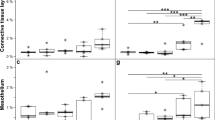Summary
The secretory tissue of the uropygial gland is of the holocrine type, containing both dividing progenitor cells and lipid-filled differentiated cells. In this study, we examined the relationship between cell division and differentiation. The location of dividing cells was determined by autoradiography of tissue sections from ducklings injected intra-abdominally with 3H-thymidine. Only cells on the basal lamina of the tubules contained labeled nuclei. Dividing cells were distributed uniformly over the length of the tubules. Over the next five days, most of the labeled cells migrated to the lumen of the tubules and disappeared. Cells containing the “lipogenic” enzymes, fatty acid synthase and malic enzyme, were localized either immunocytochemically using affinity-purified antibodies or cytochemically using a specific assay for malic enzyme activity. Fatty acid synthase and malic enzyme were undetectable in dividing basal cells but present at high levels in differentiating and differentiated cells. Thus, basal cells lying along the basal lamina of the tubules were replacing lipid-laden cells that were continually sloughed into the lumens of the tubules. The signals for differentiation and enzyme accumulation appear to be linked to one another and to cessation of cell division.
Similar content being viewed by others
References
Abalain JH, Amet Y, Lecaque D, Secchi J, Daniel JY, Floch HH (1986) Ultrastructural changes in the uropygial gland of the male Japanese quail, Coturnix coturnix, after testerone treatment. Comparison with the sebaceous gland of the male rat. Cell Tissue Res 246:373–378
Bride J, Gomot L (1978) Changes at the ecto-mesodermal interface during development of the duck preen gland. Cell Tissue Res 194:141–149
Cater DB, Lawrie NR (1950) Some histochemical and biochemical observations on the preen gland. J Physiol 111:231–243
Dentler WL, Granett S, Rosenbaum JL (1975) Ultrastructural localization of the high molecular weight proteins associated with in vitro-assembled brain microtubules. J Cell Biol 65:237–241
Dreyfuss G, Adam SA, Choi YD (1984) Physical change in cytoplasmic messenger ribonucleoproteins in cells treated with inhibitors of mRNA transcription. Mol Cell Biol 4:415–423
Glynias MJ, Morris SM Jr, Fantozzi DA, Winberry LK, Back DW, Fisch JE, Goodridge AG (1984) A cloned cDNA for duck malic enzyme detects abnormally large malic enzyme mRNAs in a strain of mice (Mod-1n) that does not express malic enzyme protein. Biochemistry 23:3454–3459
Gomot L (1959) Contribution à l'élude du développement embryonnaire de la glande uropygienne chez le canard. Arch Anat Microsc Morphol Exp 48:64–141
Goodridge AG (1972) Regulation of the activity of acetyl coenzyme A carboxylase by palmitoyl coenzyme A and citrate. J Biol Chem 247:6946–6952
Goodridge AG, Adelman TG (1976) Regulation of malic enzyme synthesis by insulin, triiodothyronine, and glucagon in liver cells in culture. J Biol Chem 251:3027–3032
Goodridge AG, Jenik RA, McDevitt MA, Morris SM Jr, Winberry LK (1984) Malic enzyme and fatty acid synthase in the uropygial gland and liver of embryonic and neonatal ducklings. Tissue-specific regulation of gene expression. Arch Biochem Biophys 230:82–92
Henderson NS (1966) Isozymes and genetic control of NADP-malate dehydrogenase in mice. Arch Biochem Biophys 117:28–33
Hsu S-M, Soban E (1982) Color modification of diaminobenzidine (DAB) precipitation by metallic ions and its application for double immunohistochemistry. J Histochem Cytochem 30:1079–1082
Hsu RY, Lardy HA (1967) Pigeon liver malic enzyme. II. Isolation, crystallization, and some properties. J Biol Chem 242:520–526
Hsu RY, Yun SL (1970) Stabilization and physicochemical properties of the fatty acid synthetase of chicken liver. Biochemistry 9:239–245
Hsu RY, Wasson G, Porter JW (1965) The purification and properties of the fatty acid synthetase of pigeon liver. J Biol Chem 240:3736–3746
Jacob J, Ziswiler V (1982) The uropygial gland. In Farner DS, King JR, Parkes KC (eds): Avian Biology, Vol VI. Academic Press New York, pp 199–324
Lowry OH, Rosebrough NJ, Farr AL, Randall RJ (1951) Protein measurement with folin phenol reagent. J Biol Chem 193:265–275
Lucas AM, Stettenheim PR (1972) Avian Anatomy: Integument. Agriculture Handbook 362. US Dept Agriculture, Washington DC, pp 613–626
Luftig RB, McMillan PN, Weatherbee JA, Weihing RR (1977) Increased visualization of microtubules by an improved fixation procedure. J Histochem Cytochem 25:175–187
Marcum JM, Pardue RL, Pepper DA, Wible L, Cox SM, Brinkley BR (1980) Tubulin antibody: A practical guide for immunization, purification, and immunofluorescence. In Schrader WT, O'Malley BW (eds) Laboratory Methods Manual for Hormone Action and Molecular Endocrinology 4th ed p 12–1 to 12–30, Baylor College of Medicine, Houston, TX
Montagna W (1963) The sebaceous glands in man. In: Montagna W, Ellis RA, Silver AF (eds) Advances in Biology of Skin Vol 4, Pergamon Press, NY, pp 19–31
Noble RE, Stjernholm RL, Mercier D, Lederer E (1963) Incorporation of proprionic acid into a branched-chain fatty acid of the preen gland of the goose. Nature 199:600–601
Sawaya WN, Kolattukudy PE (1972) Structure and biosynthesis of diesters of alkane-2,3-diols of the uropygial glands of ringnecked pheasants. Biochemistry 11:4398–4406
Silpananta P, Goodridge AG (1971) Synthesis and degradation of malic enzyme in chick liver. J Biol Chem 246:5754–5761
Soulié J-M, Sheplock GJ, Tian W-x, Hsu RY (1984) Transient kinetic studies of fatty acid synthase. A kinetic self-editing mechanism for the loading of acetyl and malonyl residues and the role of coenzyme A. J Biol Chem 259:134–140
Sternberger LA, Hardy PH Jr, Cuculis JJ, Meyer HG (1970) The unlabeled antibody enzyme method of immunohistochemistry. Preparation and properties of soluble antigen-antibody complex (horseradish peroxidase-antihorseradish peroxidase) and its use in identification of spirochetes. J Histochem Cytochem 18:315–333
Tang BY, Hansen IA (1972) Lipogenesis in chicken uropygial glands. Eur J Biochem 31:372–377
Wagner RC, Boord RL (1975) Cytological differentiation in the uropygial gland. J Morphol 146:395–414
Wise EM Jr, Ball EG (1964) Malic enzyme and lipogenesis. Proc Natl Acad Sci USA 52:1255–1263
Author information
Authors and Affiliations
Rights and permissions
About this article
Cite this article
Jenik, R.A., Fisch, J.E. & Goodridge, A.G. Terminal differentiation in the avian uropygial gland. Accumulation of fatty acid synthase and malic enzyme in non-dividing cells. Cell Tissue Res. 250, 315–321 (1987). https://doi.org/10.1007/BF00219076
Accepted:
Issue Date:
DOI: https://doi.org/10.1007/BF00219076




